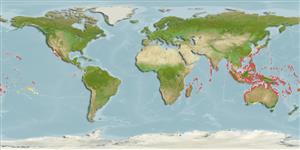Common names from other countries
Environment: milieu / climate zone / depth range / distribution range
экология
морской ассоциированный с рифами; пределы глубины 8 - 20 m (Ref. 9710). Tropical; 35°N - 35°S
Indo-Pacific: East Africa to Samoa, north to southern Japan, south to New South Wales and Tonga.
Size / Вес / Возраст
Maturity: Lm ? range ? - ? cm
Max length : 13.0 cm SL самец/пол неопределен; (Ref. 48637)
колючие лучи спинного плавника (общее число) : 1 - 2; членистые (мягкие) лучи спинного плавника (общее число) : 29 - 34; колючие лучи анального плавника: 0; членистые (мягкие) лучи анального плавника: 26 - 30. Body and head color variable. Blackish to dark bluish branchial blotch extending dorsally to level well above the lower margin of eye and may include ventrally the pectoral fin base and axil. Iris usually dark brown. Orange to red caudal fin soft dorsal and anal fins clear, orange or yellow with spots; pectorals clear. Scale spinulation at midbody closely packed. Male scale ridge rugosities develop at about 80 mm SL developed. Strong first dorsal spine. Large pelvic fin rudiment narrowly attached to posterior margin of ventral flap.
Occurs in shallow lagoons and seaward reefs to a depth of about 15 m; common in coral-rich areas. Secretive species (Ref. 9710, 48637) among rocks, sponges or in crevices on the bases of large coral formations. Adults usually form pairs but often only one is observed while the other one is hiding (Ref. 48637).
Life cycle and mating behavior
Maturities | размножение | Spawnings | Egg(s) | Fecundities | личинки
Hutchins, J.B., 1986. Review of the monacanthid fish genus Pervagor, with descriptions of two new species. Indo-Pac. Fish. (12):35 p. (Ref. 527)
Статус Красного Списка МСОП (Ref. 130435)
CITES (Ref. 128078)
Not Evaluated
Угроза для людей
Harmless
Использование человеком
дополнительная информация
инструменты
Специальные отчеты
Скачать в формате XML
ресурсы в Интернет
Estimates based on models
Preferred temperature (Ref.
115969): 23.7 - 29.2, mean 28.1 (based on 2532 cells).
Phylogenetic diversity index (Ref.
82804): PD
50 = 0.5039 [Uniqueness, from 0.5 = low to 2.0 = high].
Bayesian length-weight: a=0.01995 (0.01140 - 0.03492), b=2.93 (2.78 - 3.08), in cm Total Length, based on LWR estimates for this species & (Sub)family-body (Ref.
93245).
Trophic level (Ref.
69278): 2.9 ±0.4 se; based on size and trophs of closest relatives
устойчивость к внешним воздействиям (Ref.
120179): высокий, минимальное время удвоения популяции до 15 месяцев (Preliminary K or Fecundity.).
Fishing Vulnerability (Ref.
59153): Low vulnerability (10 of 100).
